1999 TOYOTA LAND CRUISER warning
[x] Cancel search: warningPage 89 of 202

New L/C100(U)97
(g) SRS Warning Light
This light will come on when the igni-
tion key is turned to the ºACCº or
ºONº position. After about 6 seconds,
the light will go off. This means the
system of the airbag and front seat belt
pretensioners are operating properly.
The warning light system monitors the air-
bag sensor assembly, front airbag sen-
sors, seat belt pretensioner assemblies,
inflators, warning light, interconnecting wir-
ing and power sources.
If either of the following conditions occurs,
this indicates a malfunction somewhere in
the parts monitored by the warning light
system. Contact your Toyota dealer as
soon as possible to service the vehicle.
� The light does not come on when the
ignition key is turned to the ºACCº or
ºONº position or remains on.
� The light comes on or flashes while
driving. (h) ºABSº Warning Light
This light warns that there is a problem
somewhere in your anti- lock brake sys-
tem.
If it comes on while you are driving, have
your vehicle checked by your Toyota deal-
er as soon as possible. However, it is
normal if the light goes out.
The light will come on when the ignition
key is turned to the ºONº position. After
a few seconds, the light will go off. There
may be the case that the ºABSº warning
light stays on for about 60 seconds after
the engine is started. It is normal if it
goes out after a while.
Depressing the brake pedal repeatedly
may turn on the light. It is normal if it
goes off after a few seconds.
When the ºABSº warning light is on (and
the brake system warning light is off), the
brake system operates conventionally but
anti- lock brake system is not assisting
brake performance so that the wheels can
lock- up during sudden braking or braking
on slippery road surfaces.
However, the anti- lock brake system does
not operate when the rear differential is
locked. It is normal operation for the
ºABSº warning light to be on at this time.
CAUTION
While the ºABSº warning light is on,
if either of the following conditions
occurs, immediately stop your vehicle
at a safe place and contact your
Toyota dealer. �
The brake system warning light
stays on even with the parking
brake being released.
� The brake system warning light and
buzzer come on.
In either case, the brakes may not
work properly. If they do not work
well, depress the brake pedal firmly.
(i) Open Door Warning Light
This light remains on until all the side
doors and back door are completely
closed.
(j) Unengaged ºParkº Warning Light
This light warns that the transmission
ºParkº mechanism is not engaged. If the
four- wheel drive control is in the ºNº posi-
tion while the selector lever is in the ºPº
position, the transmission will disengage
and the wheels will not lock.
Page 90 of 202
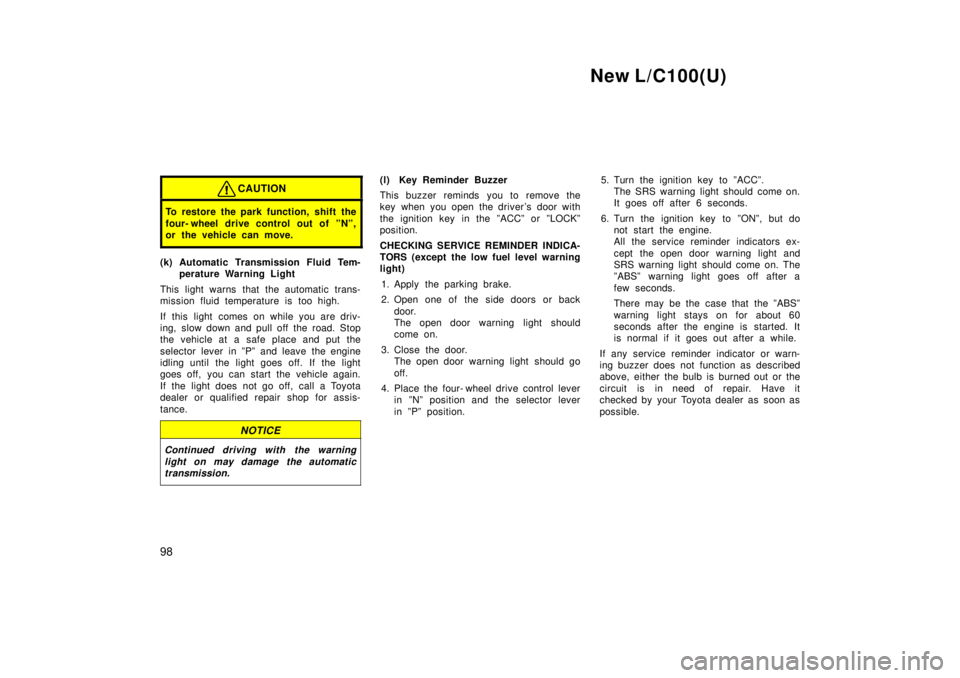
New L/C100(U)
98
CAUTION
To restore the park function, shift the
four- wheel drive control out of ºNº,
or the vehicle can move.
(k) Automatic Transmission Fluid Tem- perature Warning Light
This light warns that the automatic trans-
mission fluid temperature is too high.
If this light comes on while you are driv-
ing, slow down and pull off the road. Stop
the vehicle at a safe place and put the
selector lever in ºPº and leave the engine
idling until the light goes off. If the light
goes off, you can start the vehicle again.
If the light does not go off, call a Toyota
dealer or qualified repair shop for assis-
tance.
NOTICE
Continued driving with the warning light on may damage the automatictransmission.
(l) Key Reminder Buzzer
This buzzer reminds you to remove the
key when you open the driver 's door with
the ignition key in the ºACCº or ºLOCKº
position.
CHECKING SERVICE REMINDER INDICA-
TORS (except the low fuel level warning
light)
1. Apply the parking brake.
2. Open one of the side doors or back door.
The open door warning light should
come on.
3. Close the door. The open door warning light should go
off.
4. Place the four- wheel drive control lever in ºNº position and the selector lever
in ºPº position. 5. Turn the ignition key to ºACCº.
The SRS warning light should come on.
It goes off after 6 seconds.
6. Turn the ignition key to ºONº, but do not start the engine.
All the service reminder indicators ex-
cept the open door warning light and
SRS warning light should come on. The
ºABSº warning light goes off after a
few seconds.
There may be the case that the ºABSº
warning light stays on for about 60
seconds after the engine is started. It
is normal if it goes out after a while.
If any service reminder indicator or warn-
ing buzzer does not function as described
above, either the bulb is burned out or the
circuit is in need of repair. Have it
checked by your Toyota dealer as soon as
possible.
Page 98 of 202
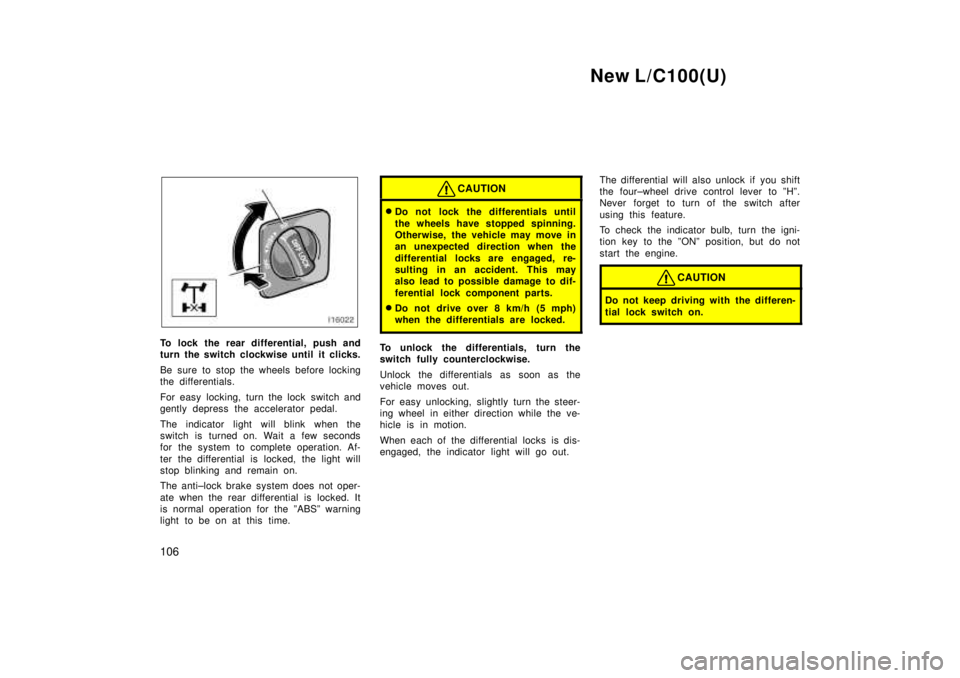
New L/C100(U)
106
To lock the rear differential, push and
turn the switch clockwise until it clicks.
Be sure to stop the wheels before locking
the differentials.
For easy locking, turn the lock switch and
gently depress the accelerator pedal.
The indicator light will blink when the
switch is turned on. Wait a few seconds
for the system to complete operation. Af-
ter the differential is locked, the light will
stop blinking and remain on.
The anti±lock brake system does not oper-
ate when the rear differential is locked. It
is normal operation for the ºABSº warning
light to be on at this time.
CAUTION
� Do not lock the differentials until
the wheels have stopped spinning.
Otherwise, the vehicle may move in
an unexpected direction when the
differential locks are engaged, re-
sulting in an accident. This may
also lead to possible damage to dif-
ferential lock component parts.
� Do not drive over 8 km/h (5 mph)
when the differentials are locked.
To unlock the differentials, turn the
switch fully counterclockwise.
Unlock the differentials as soon as the
vehicle moves out.
For easy unlocking, slightly turn the steer-
ing wheel in either direction while the ve-
hicle is in motion.
When each of the differential locks is dis-
engaged, the indicator light will go out. The differential will also unlock if you shift
the four±wheel drive control lever to ºHº.
Never forget to turn of the switch after
using this feature.
To check the indicator bulb, turn the igni-
tion key to the ºONº position, but do not
start the engine.
CAUTION
Do not keep driving with the differen-
tial lock switch on.
Page 101 of 202

New L/C100(U)109
RESETTING AT A FASTER SPEED
Push the lever up in the ºRES/ACCº direc-
tion and hold it. Release the lever when
the desired speed is attained. While the
lever is held up, the vehicle will gradually
gain speed.
However, a faster way to reset is to ac-
celerate the vehicle and then push the
control lever down in the ºSET/COASTº
direction.
RESETTING AT A SLOWER SPEED
Push the lever down in the ºSET/COASTº
direction and hold it. Release the lever
when the desired speed is attained. While
the lever is held down, the vehicle speed
will gradually decrease.
However, a faster way to reset is to de-
press the brake pedal and then push the
control lever down in the ºSET/COASTº
direction.
Even if you downshift the transmission by
turning off the overdrive switch, with the
cruise control on, engine braking will not
be applied because the cruise control is
not cancelled. To decrease the vehicle
speed, reset to a slower speed with the
cruise control lever or depress the brake
pedal. If you use the brake pedal, cruise
control is cancelled.
RESUMING THE PRESET SPEED
If the preset speed is cancelled by pu
lling
the control lever or by depressing the
brake pedal or clutch pedal, pushing the
lever up in the ºRES/ACCº direction will
restore the speed set prior to cancellation.
However, once the vehicle speed falls be-
low about 40 km/h (25 mph), the preset
speed will not be resumed.
CRUISE CONTROL FAILURE WARNING
If the ºCRUISEº indicator light in the
instrument cluster flashes when using the
cruise control, press the ºCRUISE
ON´OFFº button to turn the system off and
then press it again to turn it on. If any of the following conditions then oc-
curs, there is some trouble in the cruise
control system.
� The indicator light does not come on.
� The indicator light flashes again.
� The indicator light goes out after it
comes on.
If this is the case, contact your Toyota
dealer and have your vehicle inspected.
Page 138 of 202
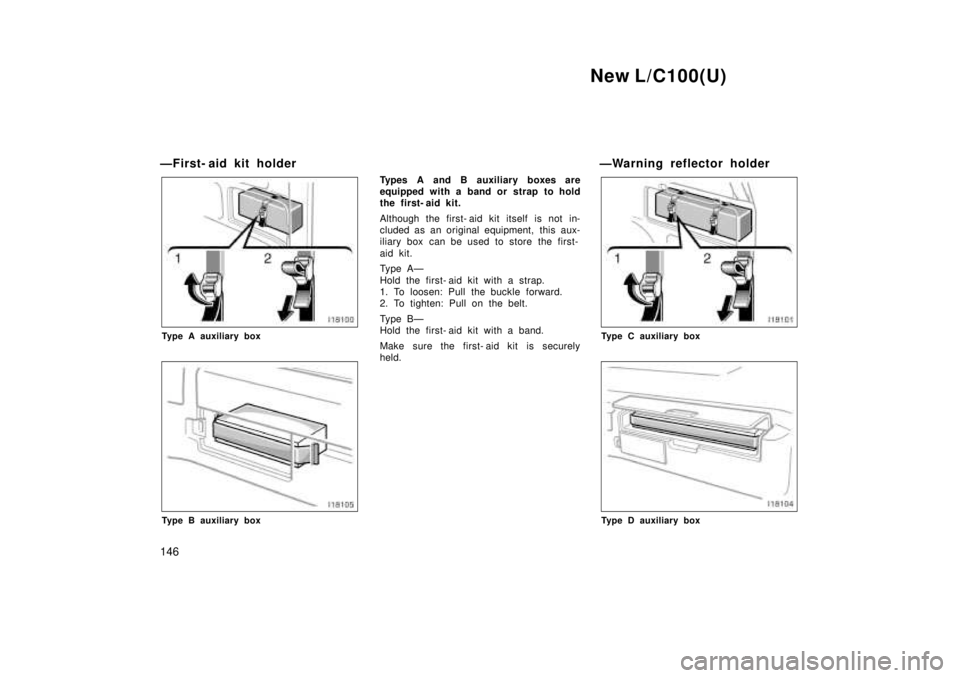
New L/C100(U)
146
ÐFirst- aid kit holder
Type A auxiliary box
Type B auxiliary box
Types A and B auxiliary boxes are
equipped with a band or strap to hold
the first- aid kit.
Although the first- aid kit itself is not in-
cluded as an original equipment, this aux-
iliary box can be used to store the first-
aid kit.
Ty p e A Ð
Hold the first- aid kit with a strap.
1. To loosen: Pull the buckle forward.
2. To tighten: Pull on the belt.
Ty p e B Ð
Hold the first- aid kit with a band.
Make sure the first- aid kit is securely
held.
ÐWarning reflector holder
Type C auxiliary box
Type D auxiliary box
Page 139 of 202
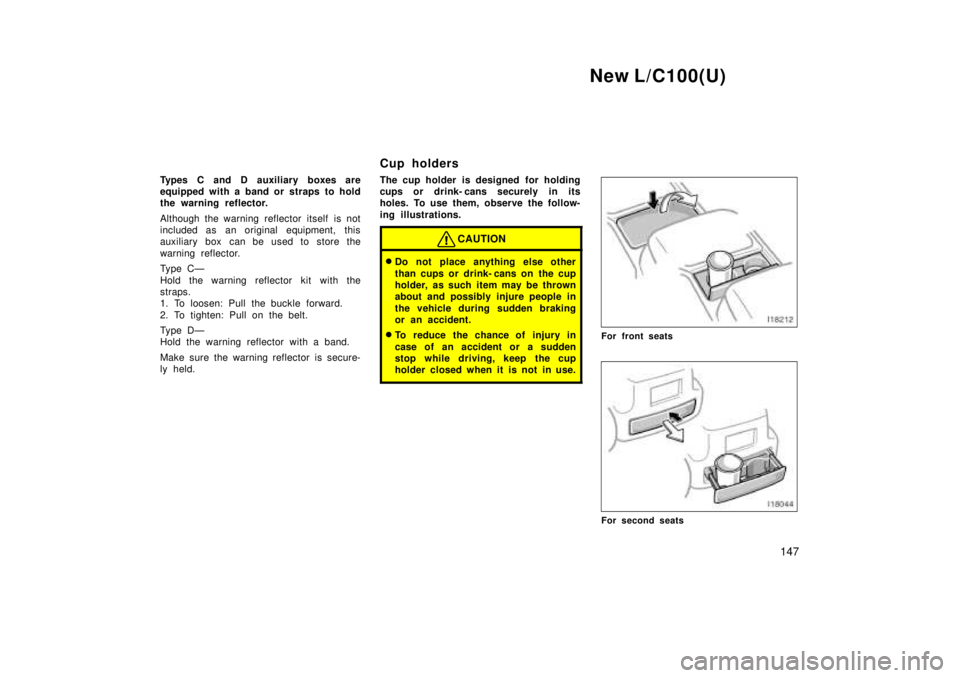
New L/C100(U)147
Types C and D auxiliary boxes are
equipped with a band or straps to hold
the warning reflector.
Although the warning reflector itself is not
included as an original equipment, this
auxiliary box can be used to store the
warning reflector.
Ty p e C Ð
Hold the warning reflector kit with the
straps.
1. To loosen: Pull the buckle forward.
2. To tighten: Pull on the belt.
Ty p e D Ð
Hold the warning reflector with a band.
Make sure the warning reflector is secure-
ly held.
Cup holders
The cup holder is designed for holding
cups or drink- cans securely in its
holes. To use them, observe the follow-
ing illustrations.
CAUTION
�
Do not place anything else other
than cups or drink- cans on the cup
holder, as such item may be thrown
about and possibly injure people in
the vehicle during sudden braking
or an accident.
� To reduce the chance of injury in
case of an accident or a sudden
stop while driving, keep the cup
holder closed when it is not in use.
For front seats
For second seats
Page 150 of 202
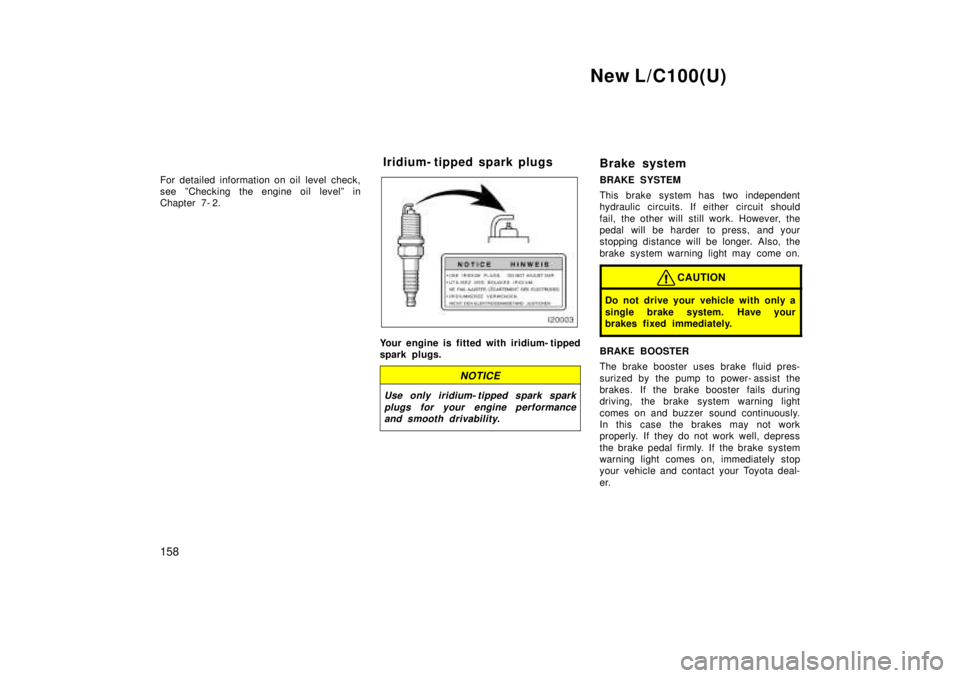
New L/C100(U)
158
For detailed information on oil level check,
see ºChecking the engine oil levelº in
Chapter 7- 2.
Your engine is fitted with iridium- tipped
spark plugs.
NOTICE
Use only iridium- tipped spark spark
plugs for your engine performanceand smooth drivability.
Brake system
BRAKE SYSTEM
This brake system has two independent
hydraulic circuits. If either circuit should
fail, the other will still work. However, the
pedal will be harder to press, and your
stopping distance will be longer. Also, the
brake system warning light may come on.
CAUTION
Do not drive your vehicle with only a
single brake system. Have your
brakes fixed immediately.
BRAKE BOOSTER
The brake booster uses brake fluid pres-
surized by the pump to power- assist the
brakes. If the brake booster fails during
driving, the brake system warning light
comes on and buzzer sound continuously.
In this case the brakes may not work
properly. If they do not work well, depress
the brake pedal firmly. If the brake system
warning light comes on, immediately stop
your vehicle and contact your Toyota deal-
er.
Iridium- tipped spark plugs
Page 151 of 202
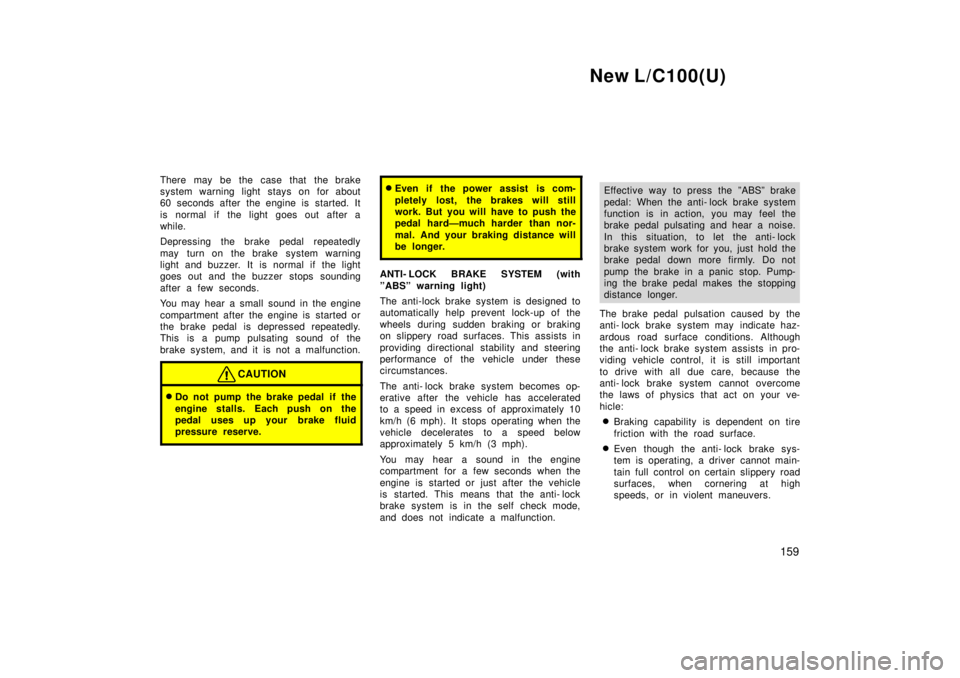
New L/C100(U)159
There may be the case that the brake
system warning light stays on for a
bout
60 seconds after the engine is started. It
is normal if the light goes out after a
while.
Depressing the brake pedal repeatedly
may turn on the brake system warning
light and buzzer. It is normal if the light
goes out and the buzzer stops sounding
after a few seconds.
You may hear a small sound in the engine
compartment after the engine is started or
the brake pedal is depressed repeatedly.
This is a pump pulsating sound of the
brake system, and it is not a malfunction.
CAUTION
� Do not pump the brake pedal if the
engine stalls. Each push on the
pedal uses up your brake fluid
pressure reserve.
�Even if the power assist is com-
pletely lost, the brakes will still
work. But you will have to push the
pedal hardÐmuch harder than nor-
mal. And your braking distance will
be longer.
ANTI- LOCK BRAKE SYSTEM (with
ºABSº warning light)
The anti-lock brake system is designed to
automatically help prevent lock-up of the
wheels during sudden braking or braking
on slippery road surfaces. This assists in
providing directional stab ility and steering
performance of the vehicle under these
circumstances.
The anti- lock brake system becomes op-
erative after the vehicle has accelerated
to a speed in excess of approximately 10
km/h (6 mph). It stops operating when the
vehicle decelerates to a speed below
approximately 5 km/h (3 mph).
You may hear a sound in the engine
compartment for a few seconds when the
engine is started or just after the vehicle
is started. This means that the anti- lock
brake system is in the self check mode,
and does not indicate a malfunction.
Effective way to press the ºABSº brake
pedal: When the anti- lock brake system
function is in action, you may feel the
brake pedal pulsating and hear a noise.
In this situation, to let the anti- lock
brake system work for you, just hold the
brake pedal down more firmly. Do not
pump the brake in a panic stop. Pump-
ing the brake pedal makes the stopping
distance longer.
The brake pedal pulsation caused by the
anti- lock brake system may indicate haz-
ardous road surface conditions. Although
the anti- lock brake system assists in pro-
viding vehicle control, it is still important
to drive with all due care, because the
anti- lock brake system cannot overcome
the laws of physics that act on your ve-
hicle: � Braking capab ility is dependent on tire
friction with the road surface.
� Even though the anti- lock brake sys-
tem is operating, a driver cannot main-
tain full control on certain slippery road
surfaces, when cornering at high
speeds, or in violent maneuvers.